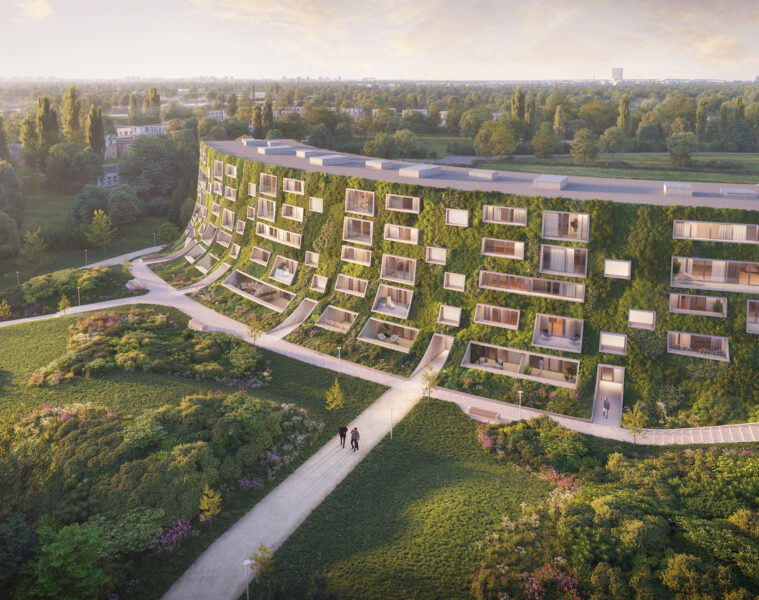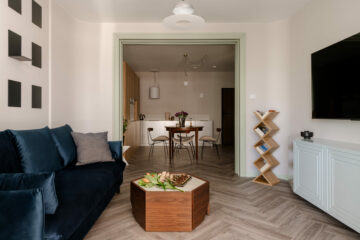The pond on Dolna Street in Warsaw is located in the Olga and Andrzej Małkowski Square in Mokotów district. The reservoir was neglected, overgrown, silted up, full of waste, including construction waste, and the surrounding area was uneven and waterlogged. Residents asked the city authorities to save the reservoir as part of the Civic Budget programme. The project was favourably received by both Mokotow residents and the authorities themselves. As a result, the pond at Dolna Street and its surroundings are greener, the water quality in the pond has improved, new plants and rafts on the reservoir attract water birds. A new path made of mineral paving – in place of a pavement – benches and litter bins are also an amenity for residents.
The pond at Dolna Street in Warsaw after revitalisation
“We have completed the project from the civic budget entitled ‘We save the pond at Dolna Street’. We started the work in 2022 with the bioremediation of the pond to restore the biological balance in it. At our request, ACS Poland carried out, among other things, water quality tests, applied probiotic microbiological preparations and carried out a fish inventory. Vegetation planting was also carried out in the so-called ecotone zone, i.e. the transition zone between land and water. In order to effectively clean the water and increase biodiversity, the following plants were planted: broad-leaved clubmoss, branched coneflower, water plantain, waterside mint, sword-leaved manna, yellow iris and marsh melon. Measurements of water and bottom sediments and application of preparations were repeated in 2023. The tests showed an improvement in the physico-chemical parameters of the water and bottom sediments in the pond. A final report will be prepared next year. However, the positive effects of our activities can now be seen. Thanks to the maintenance work, the pond is no longer so overgrown with rush vegetation. In late autumn, we mowed some of the reeds, removed the rhizomes rooting in the bottom and the waste deposited in the pond. We are leaving small islands so that in case of danger the birds – especially the young ones – can hide from predators.” – reads the announcement on the website of the Warsaw Urban Greenery Management Board
An interesting fact may be the way the work was carried out, for which a floating mower was used. Thanks to its additional accessory in the form of a soil-cutter, it was also possible to remove rhizomes forming a compacted clump from the central part of the reservoir. In addition, the northeastern part of the reservoir was reinforced with a fascine wall. This will prevent the bank from being washed up on the side most frequently used by residents, and the water level will be slightly higher to the benefit of the aquatic ecosystem.
New path instead of pavement
The path route has been laid out to create a buffer zone between the pond and the area frequented by residents. This area will only be mowed once a year – in the autumn – which will have a positive impact on the functioning of the pond as a habitat for many organisms associated with the aquatic environment. In addition, a walkway of lintels with gravel has been created in the lowered area along the course of the path, so that when water levels in the pond are high, it can flow freely into the meadow growing on the green space.
Plants, bird rafts and an information board
“At the pond we have put up an information board about the harm of feeding birds with bread and food scraps. In order to support the birds, we have planted plants whose fruit will provide them with food such as mountain ash, calla, wild rose and blackthorn. It is worth mentioning that we have been setting up rafts to improve the habitat for the birds since 2020. There are more and more of them at the pond – this year we could admire, among others, common coots, mallards and common coots.” – reads the ZZM website
Independently of the project, trees such as weeping willow, white poplar and horse chestnut have been planted by the pond, with a view to children using the natural playground located next to the pond. The playground was previously created as part of the civic budget project ‘Rain gardens and natural playgrounds in the area of the City of Warsaw, including a playground in Dolina Służewiecka Park’.
source: Warsaw Greenery Management Board / https://zzw.waw.pl/
Read also: Architecture in Poland | Places, Squares, Parks | Warsaw | Ecology | Greenery | Animals | whiteMAD on Instagram






























